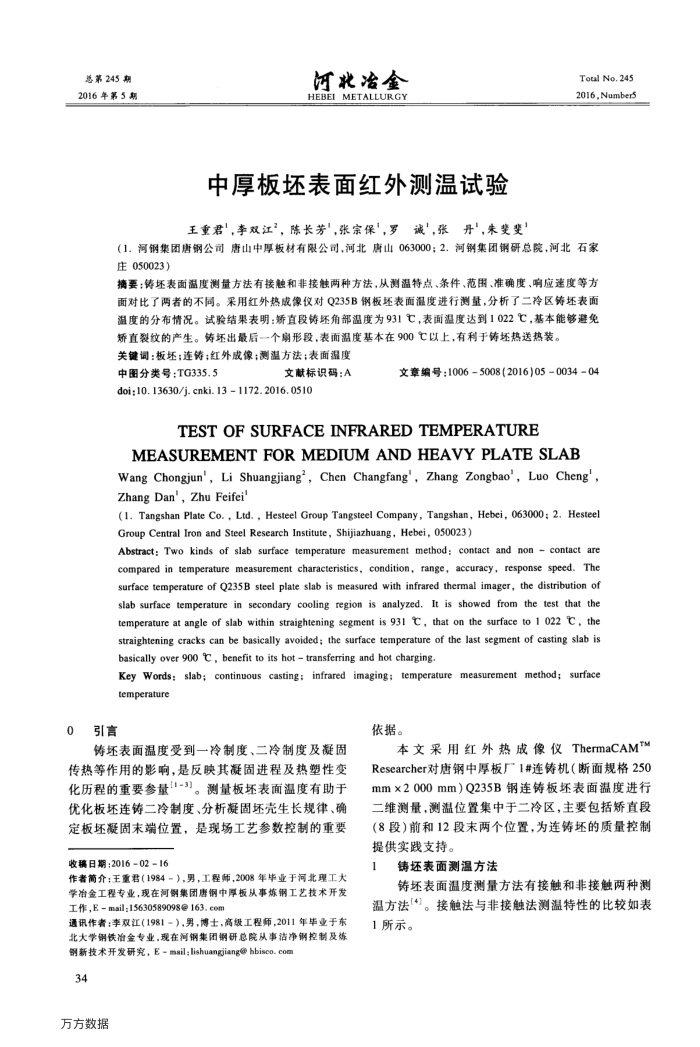您当前的位置:首页>论文资料>中厚板坯表面红外测温试验
内容简介
 0
0总第245期 2016年第5期
河北冶金 HEBEI METALLURGY
中厚板坏表面红外测温试验王重君",李双江”,陈长芳",张宗保,罗
诚,张丹”,朱斐斐
Total No.245 2016,Number5
(1.河铜集团唐钢公司唐山中厚板材有限公司,河北唐山063000;2.河钢集团钢研总院,河北石家庄050023)
携要:铸坏表面温度测量方法有接触和非接触两种方法,从测温特点、条件、范围、准确度、响应速度等方面对比了两者的不同。采用红外热成像仪对Q235B钢板坏表面温度进行测量,分析了二冷区等坏表面温度的分布情况。试验结果表明:矫直段铸还角部温度为931℃,表面温度达到1022,基本能够避免矫直裂纹的产生。铸坏出最后一个扇形段,表面温度基本在900℃以上,有利于铸坏热送热装。
关键调:板坏;连铸;红外成像;测温方法;表面温度
中图分类号:TG335.5
文献标识码:A
doi:10. 13630/j. cnki. 13 1172.2016. 0510
文章编号:10065008(2016)05003404
TESTOF SURFACEINFRAREDTEMPERATURE
MEASUREMENTFORMEDIUMANDHEAVYPLATESLAB Wang Chongjun',Li Shuangjiang', Chen Changfang',Zhang Zongbao', Luo Cheng', Zhang Dan', Zhu Feifei'
(1. Tangshan Plate Co. , Ltd. , Hesteel Group Tangsteel Company, Tangshan, Hebei, 063000; 2. Hesteel Group Central Iron and Steel Research Institute, Shijiazhuang, Hebei, 050023)
Abstract: Two kinds of slab surface temperature measurement method: contact and non - contact are compared in temperature measurement characteristics, condition, range, accuracy, response speed.
The
oaeeeseaaseadan slab surface temperature in secondary cooling region is analyzed. It is showed from the test that the temperature at angle of slab within straightening segment is 931 C, that on the surface to 1 022 C, the straightening cracks can be basically avoided; the surface temperature of the last segment of casting slab is basically over 900 °C , benefit to its hot transferring and hot charging.
Key Words: slab; continuous casting: infrared imaging; temperature measurement method; surface temperature
依据。
铸坏表面温度受到一冷制度、二冷制度及凝固
传热等作用的影响,是反映其凝固进程及热塑性变化历程的重要参量"-")。测量板坏表面温度有助于优化板坏连铸二冷制度、分析凝固坏壳生长规律、确定板坏凝固末端位置,是现场工艺参数控制的重要
收稿日期:2016-02-16
作者简介:王重君(1984-),男,工程师,2008年毕业于河北理工大学冶金工程专业,现在河钢集团唐钢中厚板从事炼钢工艺技术开发工作,Email;15630589098@ 163. eom
通讯作者:李双江(1981-),男,博士,高级工程师,2011年毕业于东北大学钢铁冶金专业,现在河钢集团钢研总院从事洁净钢控制及炼
钢新技术开发研究,E-mail:lishuangjiang@hbisco.com 34
万方数据
本文采用红外热成像仪ThermaCAMTM Researcher对唐钢中厚板厂1#连铸机(断面规格250 mmx2000mm)Q235B钢连铸板坏表面温度进行二维测量,测温位置集中于二冷区,主要包括矫直段(8段)前和12段末两个位置,为连铸坏的质量控制提供实践支持。
铸还表面测温方法
铸坏表面温度测量方法有接触和非接触两种测温方法("]。接触法与非接触法测温特性的比较如表 1所示。
上一章:添加铁矿粉对焦炭机械强度及反应性的影响
下一章:钢渣配煤对焦炭溶损反应动力学的影响